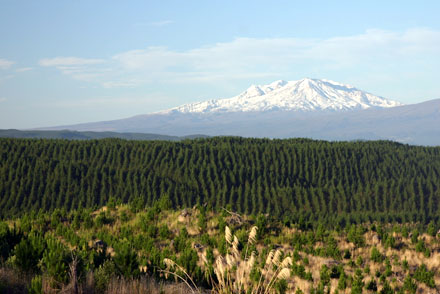
Pay rates of NZ$400 a day are not enough to attract workers to plant trees, potentially putting a brake on the New Zealand Government’s one billion trees by 2028 campaign. Forest nurseries have doubled plantings to 100 million tree seedings in response to Government incentives, but finding staff is the biggest hurdle to getting them in the ground. Source: Stuff NZ
Forest Management director David Janett said the bottleneck was not so much acquiring seedlings from forest nurseries, but finding people to plant the trees.
“We are fully booked up for this year.”
Planting rates in the North Island were reaching NZ60 cents a tree, which equated to pay rates of NZ$300 to NZ$400 a day.
“And we still can’t get people.”
“The greatest impediment is finding the labour to plant the trees. We can mechanise a lot of the work, but we can’t mechanise a person on a spade,” Mr Janett said.
Tree planting was done in autumn and winter and seasonal workers from the Pacific Islands would need to be recruited.
Forest Nursery Growers Association president Kevin Haine said its member nurseries would grow 100 million tree seedlings this year, almost double the 54m trees grown two years ago.
Of this, the Government was responsible for about 20m trees through its Crown forestry partnerships, such as its agreement to establish a commercial forest on Ngati Rehia iwi land in Northland.
Tree planting had already increased to 70m trees last year in response to demand for replanting of harvested forests, as the “wall of wood” from a peak planting in 1994 reached maturity.
“A positive aspect is that all the logged land is being replanted in trees. This is in contrast to about five years ago when carbon credits were low and it was cheap to get out of forestry and into farming.”
Pinus radiata remained the predominant species, making up about 90% of forest plantings.
“It is a quick growing tree with good wood density and characteristics.”
Eucalyptus and Douglas fir were also grown, with demand increasing for redwood.
Nursery growers were aware that a change of government might lead to a change in tree planting policy, which had occurred before, so were wary of gearing up too quickly, Mr Haine said.
“The contracts signed have only been for one year. The Government hasn’t signed any long-term contracts, so it’s year-by-year.
“However, for nurseries to scale up is reasonably doable,” said Mr Haine, nursery manager at PF Olsen.
Patrick Murray, of Murrays Nurseries at Woodville, said it had doubled plantings of pinus radiata from 5m to 10m trees in the last year, with Crown Forestry contracting a lot of the trees. This surpassed its previous peak production of 9.3m trees in the early 1990s.
Mr Murray said that while the operation could expand further, he had turned down further business in the meantime as he was cautious about having sufficient staff.
Mr Janett said the surge in tree planting meant landowners needed to consider scale, or face not being able to harvest their commercial plantation forests. There was already a shortage of forest harvest contractors in the North Island, who could choose to only log forests with scale and good access.
The Government was offering NZ$118 million in direct landholder grants to encourage the planting of trees, as well as native regeneration. Landowners had to decide whether a forest would be for production or permanent.
If planting for timber they needed scale, Mr Janett said.
“Don’t plant a five hectare woodlot and think loggers will turn up in 25-or-30 years and make you money as they won’t. Don’t plant five hectares at the back of the farm and expect loggers to turn up.”
Forest loggers had significant capital set-up costs and needed to meet increasingly stringent health and safety and environmental compliance. Contractors logged and transported timber in all weather conditions “so the days of a mud track are long gone.’
It’s only going to get harder in terms of regulation and physically finding people to turn up and do the job.
“In parts of the North Island, there are huge amounts of wood to harvest and we cannot physically get contractors to come and harvest it. Contractors can choose the biggest and most well set-up block with the easiest access.
“In 25 years, there will potentially be 50ha to 100ha blocks everywhere that need harvesting with the new planting grants and potential Emissions Trading Scheme changes,” Mr Janett said.
Returns were about 5% to 6% a year for timber only, and 9% to 10% if carbon credits from ETS were added.
Ollie Belton, a partner of Permanent Forests NZ a Christchurch-based carbon consultancy, said ETS rule changes would make permanent forests more attractive by removing the liability risk.
Permanent forests could keep earning carbon credits under ETS as long as a forest kept growing and gaining biomass.
Under existing rules the risk was that as trees aged and blew over, those carbon credits would need to be paid back. Proposed rules removed this liability if the forest was replanted.
“So this eliminates the risk of liability from a fire or a wind event and forest owners won’t need carbon insurance.”
Mr Belton said he wanted landowners to think about a long-term time-frame.
“This could initially involve planting eucalyptus and pinus radiata, then later introducing natives so that in 100 to 200 years it is a mixed species forest.”







